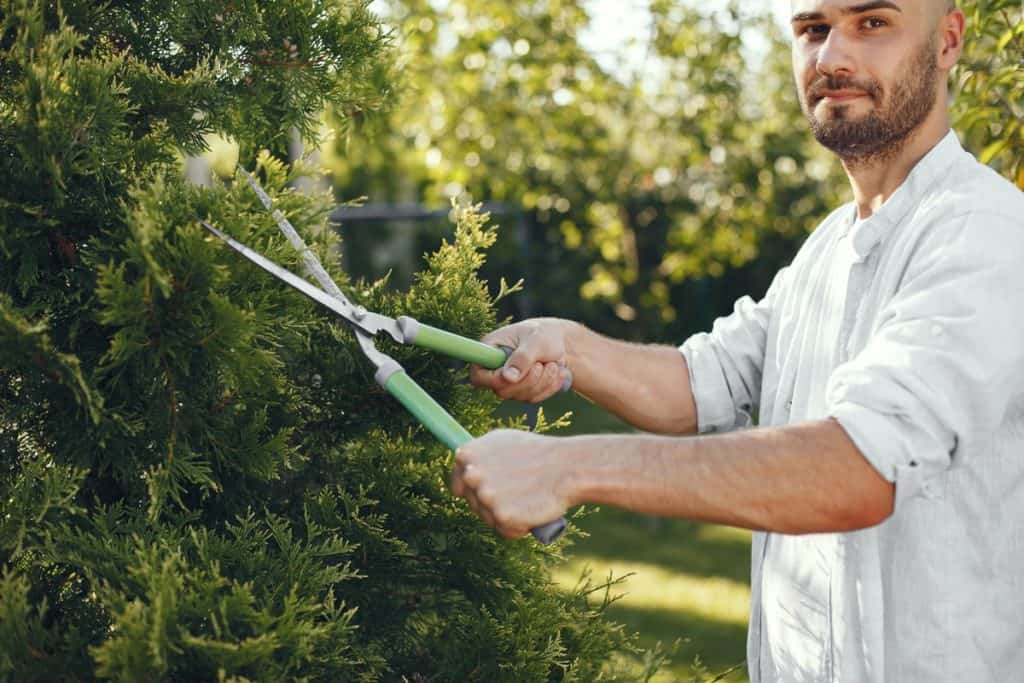We are reader-supported. When you buy through links on our site, we may earn an affiliate commission.
Picture this — you’ve been extremely busy and walk outside for a little relaxation, only to find your green space overgrown. Or, you’ve just moved to a new home only to discover that the previous owner lacked a green thumb. Is reviving your overgrown garden possible?
Garden renovation can be a daunting task, especially if it’s been some time since you’ve tended to it. Overgrown shrubs, crawling vines, carpets of weeds and multiplying perennials can dissuade the most avid gardener from picking up their gloves and trowel.
Should you throw in the towel and let nature reclaim your space? No! Reviving an overgrown garden isn’t as impossible as it seems. Instead, follow the steps below to give your green space a complete makeover.
- Tidy and Mow the Garden Area
- Practice Weed Control
- Lay Down Organic Mulch
- Prune or Remove Unwanted Plants
- Replenish Perennial Gardens

1. Tidy and Mow Your Garden Area
The first step to reviving your overgrown garden is to get out and take a hard look at it. It’s easy to overlook things when weeds and shrubs have taken over. First, remove any trash or debris that may have blown into the area. Next, collect garden tools, broken pots and empty sacking. If it isn’t a plant, get it out of there.
Then, focus your efforts on mowing and edging the perimeter. Landscaping your overgrown garden will help manage the next steps and expose areas that need the most attention. Your garden will look much better with an outline.

2. Practice Weed Control
If you want to see a big difference in a short amount of time, remove the big weeds first. Target tall grasses and large nettles. Pull them out at the root to discourage them from returning.
Moreover, once you’ve pulled the most intimidating weeds, aim for the smaller ones. To make this process more manageable, begin at one end of the garden and work your way down. If your garden is circular, start in the middle and work your way out.
Refrain from digging too deep into the soil. Thankfully, only the top inch or two of soil allows enough light for seeds to germinate. Digging will bring seeds closer to the surface and will make your life harder in the future.
Weed Remedies
If you need something a little more drastic, you can try a commercial weed killer to clean up your garden beds. While we have regulatory agencies to keep these safe, some gardeners are understandably hesitant to try them out. Flame gun weeders and organic herbicides can provide solid alternatives for many homeowners.

3. Lay Some Organic Mulch
Once you’ve removed those pesky weeds, lay some mulch to keep the soil cool and moist. Mulch will prevent weeds from taking root. Choose an organic option to encourage friendly garden pests, like crickets and ground beetles, to make your garden home. These insects eat weed seeds, preventing unwanted greenery.
Don’t feel like heading to the store? Make your own organic mulch with grass clippings, pine needles, dead leaves and more. Start a compost pile in the backyard, preferably several feet from your home. Here, you can toss materials like yard waste, food scraps, newspaper, cardboard, dryer lint and more.
Keeping your flower beds healthy requires standard maintenance. Remember to regularly replenish mulch to keep it around two inches deep.

4. Prune and Remove Unwanted Plants
Bushes, shrubs and trees tend to spread themselves out over time. Rogue branches can add to the look of an overgrown garden, making it important to prune and contain them.
In addition, certain species — like lilac and hydrangeas — can be pruned low to encourage regrowth.
On the other hand, plants like witch hazel must be trimmed over a span of years to prevent killing them. Prune smaller shrubs and bushes by one-third over three years to manage size and growth.
If some plants are driving you crazy, reclaim an overgrown garden by removing them entirely. Overgrown or diseased shrubs can be dug out with a spade and uprooted.

5. Transplant or Replenish Perennial Gardens
Perennial gardens must be revamped to contain growth and make room for other plants. First, dig out perennials in the fall and divide any plants that have grown too large. Then, transplant a few of them to other parts of your garden or compost them.
Remove the dead stalk of annual plants in the springtime and replace them with new ones. You can also plant perennials in empty spots to avoid replacing them every year. Filling your garden with healthy plant cover can further help crowd out weeds.
Get Your Overgrown Garden Under Control
Now that you’ve put in the hard work to revive your garden, make sure it stays looking great. Dedicate a few hours each week to maintaining it, especially in spring and summer when weeds pop up. Re-mulch as needed, trim and water plants and keep an eye out for pests that can eat vegetables and leaves.
With a bit of love — and a little elbow grease — your garden will be looking better than ever.







